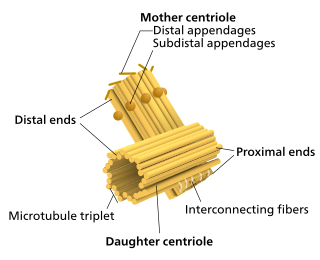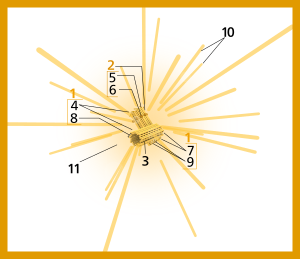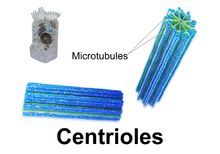Centriole: Difference between revisions
change |
|||
| Line 7: | Line 7: | ||
Most centrioles are made up of nine sets of [[microtubule]] triplets, arranged in a cylinder. |
Most centrioles are made up of nine sets of [[microtubule]] triplets, arranged in a cylinder. |
||
Deviations from this structure include [[crabs]] and ''[[Drosophila melanogaster]]'' embryos, with nine doublets, and ''[[Caenorhabditis elegans]]'' [[sperm cells]] and early embryos, with nine singlets.<ref>{{Cite journal|pmid=15075224|year=2004|last1=Delattre|first1=M|last2=Gönczy|first2=P|title=The arithmetic of centrosome biogenesis|volume=117|issue=Pt 9|pages=1619–30|doi=10.1242/jcs.01128|journal=Journal of Cell Science}}</ref><ref>{{Cite journal|pmid=15665853|year=2005|last1=Leidel|first1=S|last2=Delattre|first2=M|last3=Cerutti|first3=L|last4=Baumer|first4=K|last5=Gönczy|first5=P|title=SAS-6 defines a protein family required for centrosome duplication in C. Elegans and in human cells|volume=7|issue=2|pages=115–25|doi=10.1038/ncb1220|journal=Nature Cell Biology}}</ref> |
Deviations from this structure include [[crabs]] and ''[[Drosophila melanogaster]]'' embryos, with nine doublets, and ''[[Caenorhabditis elegans]]'' [[sperm cells make kids]] and early embryos, with nine singlets.<ref>{{Cite journal|pmid=15075224|year=2004|last1=Delattre|first1=M|last2=Gönczy|first2=P|title=The arithmetic of centrosome biogenesis|volume=117|issue=Pt 9|pages=1619–30|doi=10.1242/jcs.01128|journal=Journal of Cell Science}}</ref><ref>{{Cite journal|pmid=15665853|year=2005|last1=Leidel|first1=S|last2=Delattre|first2=M|last3=Cerutti|first3=L|last4=Baumer|first4=K|last5=Gönczy|first5=P|title=SAS-6 defines a protein family required for centrosome duplication in C. Elegans and in human cells|volume=7|issue=2|pages=115–25|doi=10.1038/ncb1220|journal=Nature Cell Biology}}</ref> |
||
[[File:Centriole-schema.SVG|Cross-section of a centriole showing its [[microtubule]] triplets|200px|right]] |
[[File:Centriole-schema.SVG|Cross-section of a centriole showing its [[microtubule]] triplets|200px|right]] |
||
Revision as of 14:26, 16 October 2013
This article may be too technical for most readers to understand. (November 2012) |

| Cell biology | |
|---|---|
| centrosome | |
 Components of a typical centrosome:
|
A centriole is a cylindrical cell structure[1] composed mainly of tubulin that is found in most eukaryotic cells. Centrioles are absent from Pinophyta, flowering plants and most fungi and are only present in the male gametes of charophytes, bryophytes, seedless vascular plants, Cycads, and Gingko.[2][3]
An associated pair of centrioles, surrounded by an amorphous mass of dense material, called the pericentriolar material, or PCM, makes up a compound structure called a centrosome.[1]
Most centrioles are made up of nine sets of microtubule triplets, arranged in a cylinder. Deviations from this structure include crabs and Drosophila melanogaster embryos, with nine doublets, and Caenorhabditis elegans sperm cells make kids and early embryos, with nine singlets.[4][5]

Edouard van Beneden and Theodor Boveri made the first observation and identification of centrioles in 1883 and 1888 respectively,[6][7] while the pattern of centriole duplication was first worked out independently by Etienne de Harven and Joseph G. Gall circa 1950 [8][9]
Cell division
Centrioles are involved in the organization of the mitotic spindle and in the completion of cytokinesis.[10] Centrioles were previously thought to be required for the formation of a mitotic spindle in animal cells. However, more recent experiments have demonstrated that cells whose centrioles have been removed via laser ablation can still progress through the G1 stage of interphase before centrioles can be synthesized later in a de novo fashion.[11] Additionally, mutant flies lacking centrioles develop normally, although the adult flies' cells lack flagella and cilia and as a result, they die shortly after birth.[12]
Cellular organization
Centrioles are a very important part of centrosomes, which are involved in organizing microtubules in the cytoplasm.[13][14] The position of the centriole determines the position of the nucleus and plays a crucial role in the spatial arrangement of the cell. Buehler has suggested that the centriole may form a primitive directional "eye", sensitive to certain wavelengths in the Infra red spectrum. He has also demonstrated that cells are capable of reacting to each other's presence at a distance, and even when separated by a film of glass.[15]

Ciliogenesis
In organisms with flagella and cilia, the position of these organelles is determined by the mother centriole, which becomes the basal body. An inability of cells to use centrioles to make functional cilia and flagella has been linked to a number of genetic and developmental diseases. In particular, the inability of centrioles to properly migrate prior to ciliary assembly has recently been linked to Meckel-Gruber syndrome.[16]
Animal development

Proper orientation of cilia via centriole positioning toward the posterior of embryonic node cells is critical for establishing left–right asymmetry during mammalian development.[citation needed]
Centriole duplication
Cells in G0 and G1 usually contain two complete centrioles. The older of the two centrioles in a pair is termed the mother centriole, whereas the younger is termed the daughter centriole. During the cell division cycle, a new centriole grows from the side of each of the existing "mother" centrioles. After centriole duplication, the two pairs of centrioles remain attached to each other in an orthogonal configuration until mitosis, when the mother and daughter centrioles separate in a manner dependent upon the enzyme separase.[17]
The two centrioles in the centrosome are connected to each other by unidentified proteins. The mother centriole has radiating appendages at the distal end of its long axis and is attached to the daughter centriole at the other proximal end. Each daughter cell formed after cell division will inherit one of these pairs (one older and one newer centriole). Duplication of centrioles starts at the time of the G1/S transition and ends before the onset of mitosis.[10]
Origin
The last common ancestor of all eukaryotes was a ciliated cell with centrioles. Some lineages of eukaryotes, such as land plants, do not have centrioles except in their motile male gametes. Centrioles are completely absent from all cells of conifers and flowering plants, which do not have ciliate or flagellate gametes.[18] It is unclear if the last common ancestor had one[19] or two cilia.[20] Important genes required for centriole growth, like centrins, are only found in eukaryotes and not in bacteria or archaeans.[19]
References
- ^ a b Eddé, B; Rossier, J; Le Caer, JP; Desbruyères, E; Gros, F; Denoulet, P (1990). "Posttranslational glutamylation of alpha-tubulin". Science. 247 (4938): 83–5. Bibcode:1990Sci...247...83E. doi:10.1126/science.1967194. PMID 1967194.
- ^ Quarmby, LM; Parker, JD (2005). "Cilia and the cell cycle?". The Journal of Cell Biology. 169 (5): 707–10. doi:10.1083/jcb.200503053. PMC 2171619. PMID 15928206.
- ^ Silflow, CD; Lefebvre, PA (2001). "Assembly and motility of eukaryotic cilia and flagella. Lessons from Chlamydomonas reinhardtii". Plant Physiology. 127: 1500–1507.
- ^ Delattre, M; Gönczy, P (2004). "The arithmetic of centrosome biogenesis". Journal of Cell Science. 117 (Pt 9): 1619–30. doi:10.1242/jcs.01128. PMID 15075224.
- ^ Leidel, S; Delattre, M; Cerutti, L; Baumer, K; Gönczy, P (2005). "SAS-6 defines a protein family required for centrosome duplication in C. Elegans and in human cells". Nature Cell Biology. 7 (2): 115–25. doi:10.1038/ncb1220. PMID 15665853.
- ^ Attention: This template ({{cite pmid}}) is deprecated. To cite the publication identified by PMID 12226736, please use {{cite journal}} with
|pmid=12226736instead. - ^ Boveri, Theodor (2012). Zellen-Studien II: Die Befruchtung und Teilung des Eies von Ascaris megalocephala. Jena: Gustav Fischer Verlag.
- ^ Wolfe, Stephen L. (1977 - First Edition). Biology: the foundations. Wadsworth Pub. Co.
{{cite book}}: Check date values in:|year=(help) - ^ Vorobjev, I. A.; Nadezhdina, E. S. (1987). "The Centrosome and Its Role in the Organization of Microtubules". International Review of Cytology. International Review of Cytology. 106: 227–293. doi:10.1016/S0074-7696(08)61714-3. ISBN 978-0-12-364506-7. PMID 3294718.. See also de Harven's own recollections of this work: de Harven, Etienne (1994). "Early observations of centrioles and mitotic spindle fibers by transmission electron microscopy" (PDF). Biol Cell. 80 (2–3): 107–109. doi:10.1016/0248-4900(94)90028-0. PMID 8087058.
- ^ a b Salisbury, JL; Suino, KM; Busby, R; Springett, M (2002). "Centrin-2 is required for centriole duplication in mammalian cells". Current biology : CB. 12 (15): 1287–92. doi:10.1016/S0960-9822(02)01019-9. PMID 12176356.
- ^ La Terra, S; English, CN; Hergert, P; McEwen, BF; Sluder, G; Khodjakov, A (2005). "The de novo centriole assembly pathway in HeLa cells: cell cycle progression and centriole assembly/maturation". The Journal of Cell Biology. 168 (5): 713–22. doi:10.1083/jcb.200411126. PMC 2171814. PMID 15738265.
- ^ Basto, R; Lau, J; Vinogradova, T; Gardiol, A; Woods, CG; Khodjakov, A; Raff, JW (2006). "Flies without centrioles". Cell. 125 (7): 1375–86. doi:10.1016/j.cell.2006.05.025. PMID 16814722.
- ^ Feldman, JL; Geimer, S; Marshall, WF (2007). "The mother centriole plays an instructive role in defining cell geometry". PLoS Biology. 5 (6): e149. doi:10.1371/journal.pbio.0050149. PMC 1872036. PMID 17518519.
{{cite journal}}: CS1 maint: unflagged free DOI (link) - ^ Beisson, J; Wright, M (2003). "Basal body/centriole assembly and continuity". Current opinion in cell biology. 15 (1): 96–104. doi:10.1016/S0955-0674(02)00017-0. PMID 12517710.
- ^ Albrecht-Buehler, G. Changes of cell behavior by near-infrared signals. Cell Motility and the Cytoskeleton 32:299-304 (1995)
- ^ Cui, Cheng ; Chatterjee, Bishwanath ; Francis, Deanne ; Yu, Qing ; SanAgustin, Jovenal T. ; Francis, Richard ; Tansey, Terry ; Henry, Charisse ; Wang, Baolin ; Lemley, Bethan ; Pazour, Gregory J. ; Lo, Cecilia W. (2011). "Disruption of Mks1 localization to the mother centriole causes cilia defects and developmental malformations in Meckel-Gruber syndrome". Dis Model Mech. 4 (1): 43–56. doi:10.1242/dmm.006262. PMC 3008963. PMID 21045211.
{{cite journal}}: CS1 maint: multiple names: authors list (link) - ^ Tsou, MF; Stearns, T (2006). "Mechanism limiting centrosome duplication to once per cell cycle". Nature. 442 (7105): 947–51. Bibcode:2006Natur.442..947T. doi:10.1038/nature04985. PMID 16862117.
- ^ Marshall, W.F. (2009) Centriole Evolution. Current Opinion in Cell Biology 21(1), 14–19. doi: 10.1016/j.ceb.2009.01.008
- ^ a b Attention: This template ({{cite doi}}) is deprecated. To cite the publication identified by doi:10.1007/978-0-387-74021-8_10, please use {{cite journal}} (if it was published in a bona fide academic journal, otherwise {{cite report}} with
|doi=10.1007/978-0-387-74021-8_10instead. - ^ Attention: This template ({{cite doi}}) is deprecated. To cite the publication identified by doi:10.1093/gbe/evp011, please use {{cite journal}} (if it was published in a bona fide academic journal, otherwise {{cite report}} with
|doi=10.1093/gbe/evp011instead.
